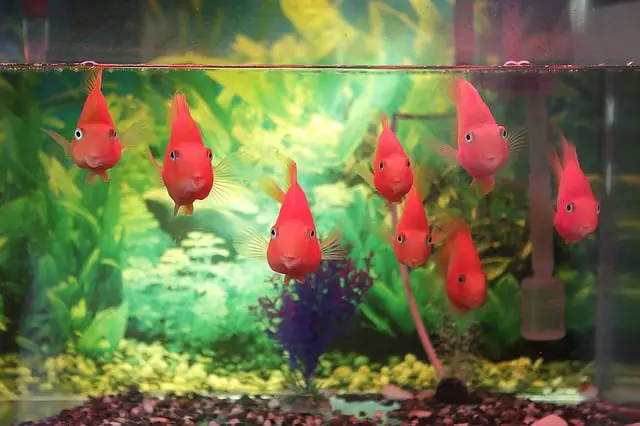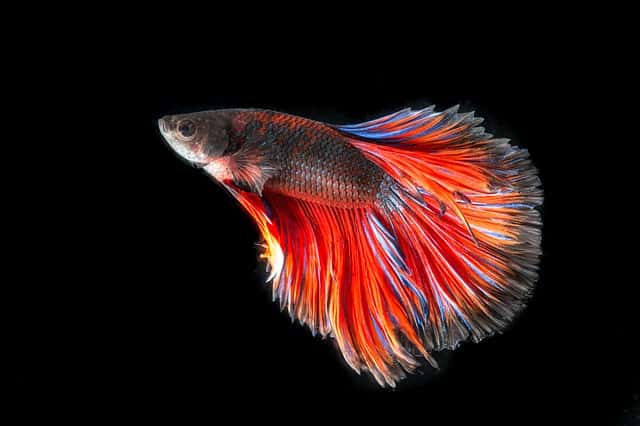Water parameters such as ammonia, nitrite and ammonia are important to keep in check whether you have a marine or freshwater tank. If you have a marine (saltwater) aquarium, the next important thing to keep in check is the salinity. It’s easy to check if you have the correct tools and it doesn’t take long at all.
To maintain salinity in a saltwater aquarium, you must check the levels regularly. Adding a marine salt mix with freshwater when performing water changes will help to keep salinity levels stable. When aquarium water level drops, just add water without a marine salt mix otherwise the salinity level will be too high.
It’s a balancing act for sure, trying to keep the salinity level consistent and safe for your fish. Fortunately, it isn’t really that hard to do when you understand what happens to the salt when water evaporates or when you perform water changes.
In this article, I’ll go over those things as well as some other goodies to help make this part of keeping a healthy marine tank easy for you. When checking the fish tanks salinity, you are looking at specific gravity and salinity.

What is the Correct Salinity for a Saltwater Tank?
Before you can test the salinity in a saltwater aquarium, you will need a saltwater refractometer. You can purchase these necessary little tools for your marine tank at your local fish store or on Amazon. Here is a saltwater refractometer on Amazon you might be interested in.
Once you have a salinity meter (refractometer,) follow the directions it came with to test your water. Most testers are marked as to where the salinity range should be, so you don’t even have to think about it as long as you are within the marked area on the tester.
For those of you that like to know more – the salinity range to be in is typically 1.017 to 1.028. The specific gravity should be around 30 for most saltwater species.
I always keep my saltwater tanks around 1.024. I only keep fish and invertebrate so I could drop the level a bit, but I have never had an issue with parasites or the fish not liking the higher salinity, so I keep it there.
I should elaborate on that last paragraph. If you plan on only having saltwater fish in your tank, then having the salinity in the range of 1.017 to 1.024 is good. You could keep the salinity at 1.017, if you’re just wanting fish and then you don’t have to spend as much money on instant ocean mix.
Lower levels of salinity are good for tanks with parasite issues as the parasites don’t survive as easily in the lower levels. Keep that in mind.
Higher levels of salinity are required if you plan on having live rock and corals. I used to have live rock, so I guess that is why I stuck with the 1.024 level.
How Do You Increase the Salinity in a Saltwater Aquarium?
There is really only one right way to increase the salinity in your aquarium. You need to take some of the existing water out of the tank and mix it with a marine mix like API or Instant Ocean.
These products can be purchased at your local fish store or online at places such as Amazon. This INSTANT OCEAN MIX is an excellent option.
There is another way that your tanks salinity will increase without adding anymore ocean mix. It happens when the water evaporates. Because the water evaporates (and salt doesn’t) it stays in the tank. This means less water and more salt which results in higher salinity levels.
How Do You Bring Salinity Down in a Saltwater Tank?
The way to bring salinity down in a saltwater tank is to take saltwater out via a water change and replace it with freshwater.
You might think that you can just add freshwater to top up evaporated water, but it doesn’t work like that. As previously mentioned, the salt in the tank stays when water evaporates.
Technically, the salinity will lower after topping up but it should lower to the level it should be at for appropriate levels for the fish.
So, the only way to bring down salinity properly is to take saltwater out and replace it with freshwater.
Does Water Temperature Affect Salinity Readings in a Saltwater Aquarium?
Yes, water temperature will affect your salinity readings. The average temperatures for saltwater aquariums will be between 75 Fahrenheit and 82 Fahrenheit. Reef aquariums will be around the lower end and fish only will be on the higher end for temperature. This means you should always be testing your tank’s salinity with the water temperature the same each time.
The higher the temperature the more the specific gravity will drop, and the salinity will be lower. At lower aquarium water temperatures, the specific gravity rises, and the salinity will be higher.
If you read the paragraph above about correct salinity, this will make sense as a fish only tank will have a higher water temperature than a reef tank therefore a lower salinity for that tank.
A reef tank where you are growing corals will have the water temperature lower than if it was fish only and the specific gravity and salinity level will be higher.
I hope this makes sense to you. Once you wrap your head around this concept it makes it much easier when looking at water temps and salinity readings. It’s not a bad idea to make a sticky note so you don’t forget.
Why Does Your Salinity Keep Rising?
Sometimes your salinity rises and you just don’t understand why. I have explained this already in this article, however, summarizing it here should help you solve this issue.
There are two things to look at when salinity levels rise, and you don’t know why.
- The temperature of the water affects the salinity levels. If the temperature happens to be higher than the last time you tested, chances are you are going to get a reading at a higher level. To solve this, make sure you keep the fish tanks water the same temperature at all times.
- If you test salinity after water has evaporated, the levels will be higher than the last time you tested. Make sure you only test when you have a full aquarium of water. The best way to solve this is to make sure you top up the tank at least once a week, as necessary.
Conclusion
I enjoyed writing this article. As simple as this is to check salinity levels, it can easily throw a new hobbyist for a loop. Of course, with experience these types of things are usually not an issue. If you remember to take care of evaporated water and keep the tanks temperature consistent, you won’t have much fluctuation when testing for salinity levels.
Sometimes salt accumulates at the top of the tank near filters or other areas that get wet. I pick those chunks of salt off and let them drop back into the tank. If you ever find that your levels are a bit high, you could just pick those chunks off and throw them away instead of putting back in the tank.
I hope I was able to help you understand how easy it is to maintain salinity in a saltwater aquarium.
Good luck!
Related Aquariums at Home Articles
Is a Cowfish a Saltwater Fish?
Can I Convert My Freshwater Tank to Saltwater?
Are Saltwater and Freshwater Filters the Same? (Learn What Filter You Should Use)
Does a Clown Fish Need Saltwater to Survive
Do Saltwater Tanks Need Air Bubbles?
RO Water: Vital for Healthy Saltwater Tanks






